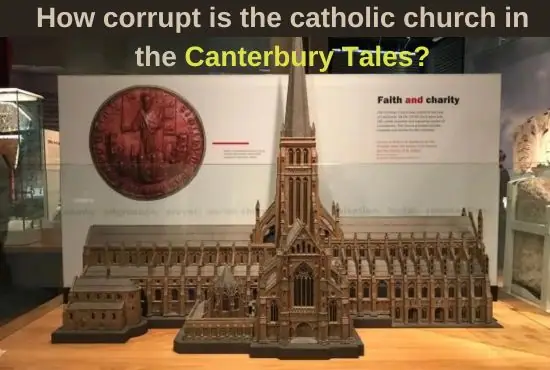Throughout the Canterbury Tales, Geoffrey Chaucer vocalizes criticisms of the Catholic Church, shedding light on the perceived corruption that existed within its ranks during the medieval period. Chaucer’s tales offer glimpses into the moral and ethical failings of various religious figures, revealing a somewhat pessimistic view of the Church. In order to evaluate the extent of corruption, it is essential to dissect the actions of the clergy depicted by Chaucer, such as the Pardoner, Friar, and Summoner. These characters engage in a range of deplorable behaviors, including the selling of indulgences, the exploitation of penitents for personal gain, and the abuse of power. However, it is important to note that Chaucer’s portrayal is likely influenced by his own personal biases and exaggerated for literary purposes, thus requiring a cautious interpretation.
The Pardoner, known for his skillful manipulation of emotions, exemplifies the Church’s corruption through his fraudulent activities. His willingness to sell false forgiveness in exchange for profit reveals a lack of integrity within the institution. Additionally, the Pardoner’s indulgent lifestyle contradicts the ideals of poverty and chastity advocated by the Church, further highlighting its moral hypocrisy.
Similarly, Chaucer’s Friar paints a vivid picture of corruption within the Catholic Church. The Friar’s primary concern is not the well-being of the people he is meant to serve, but rather his own enrichment. He employs flattery and manipulation to extort money and gifts from those seeking his counsel. This exploitation of the vulnerable demonstrates the Church’s prioritization of material gain over its spiritual duties.
Also Read:
Furthermore, Chaucer’s portrayal of the Summoner showcases the abuse of power within the Catholic Church. The Summoner, tasked with bringing sinners to court, abuses his authority by accepting bribes in exchange for ignoring misconduct. This corruption undermines the justice system and tarnishes the reputation of the Church, suggesting a fundamental breakdown of moral values.
While Chaucer’s Canterbury Tales highlight instances of corruption within the Catholic Church, it is important to consider the broader historical context. The Church wielded significant power during this period, and as with any institution of authority, there were undoubtedly individuals who abused their positions. However, it is crucial to recognize that Chaucer’s work, while providing insights into the perceived corruption, may also reflect his personal prejudices and the literary conventions of his time.
Moreover, it is worth noting that Chaucer’s portrayal of the clergy is not entirely negative. The Parson, for instance, serves as a counterexample to the corrupt figures described above. He embodies the true purpose of the Church, prioritizing the spiritual guidance and well-being of his congregation over personal gain. By including this character, Chaucer suggests that not all members of the Catholic Church were corrupt, offering a more balanced perspective.
In conclusion, Chaucer’s Canterbury Tales sheds light on the perceived corruption within the Catholic Church during the medieval period. The Pardoner, Friar, and Summoner offer compelling examples of the moral failings within the institution. However, it is crucial to approach Chaucer’s portrayal with caution, recognizing his biases and the literary conventions of his time. While the tales provide valuable insights, they should not be taken as a definitive representation of the overall state of the Catholic Church during this era. Through a nuanced examination, we can derive a more comprehensive understanding of the complexities surrounding the Church’s perceived corruption.

Hello, Viewers! Besides being the Founder and Owner of this website, I am a Government Officer. As a hardcore literary lover, I am pursuing my dream by writing notes and articles related to Literature. Drop me a line anytime, whether it’s about any queries or demands or just to share your well-being. I’d love to hear from you. Thanks for stopping by!
